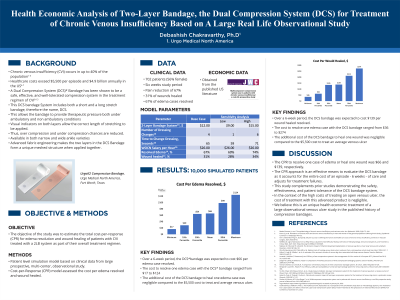Health Economics
(HE-002) Health Economic Analysis of Two-Layer Bandage, the Dual Compression System (DCS) for Treatment of Chronic Venous Insufficiency Based on A Large Real Life Observational Study

Compression therapy is the gold standard for the treatment of chronic venous insufficiency (CVI). Two-layer bandage (2LB) systems have been shown to be an effective and safe treatment option. The objective of the study was to estimate the total cost-per-wound healing response (CPR) of patients with CVI treated with a specific 2LB system as part of their overall would healing regimen. This 2LB system is the Dual Compression System (DCS), so called because it combines both short and long stretch bandages.
Methods:
A deterministic decision tree model was developed to estimate the incremental CPR for the DCS system. The analysis was performed using clinical data from a published single arm, multi-center prospective study with CVI indicated for compression therapy. [1] The outcome of interest was wound healing. The follow-up time was a maximum six weeks and perspective of the study was the US healthcare system. Economic data for compression therapy was based upon public prices of DCS system from the health system perspective. Dressing changes occurred per manufacturer instructions for use. Sensitivity analysis was performed to gauge the robustness of the results.
Results:
A total of 702 patients (56% female) of which there were a total of 414 wounds. The median duration of the wounds was 42 days and the median size at initial visit was 3.5 cm2. The average pain reduction fell by 67% using a visual analog score. Bandages were typically changed 1-2 times as week (51.7%). Wound healing occurred in 128 of the 414 wounds (30.9%) during the six week study period. The total cost of DCS system changes over the study period was $48.10 (range: $13.47 to $97.51). The total CPR for wounds healed was $155.65 (range: $48.42 to $286.88).
Discussion:
This economic evaluation complements previous clinical effectiveness and safety studies of DCS systems for the treatment of CVI. The results demonstrate that the costs incorporating DCS into standard wound-healing protocols is negligible in comparison of overall treatment costs more than $4,567. [2,3] DCS may be considered a cost-effective first line system for the treatment for wounds caused by CVI.
Trademarked Items: UrgoK2
References: 1. Stucker M, Munter KC, Erfurt-Berge C, et al. Multicomponent compression system use in patients with chronic venous insufficiency: a real-life prospective study. Journal of Wound Care. 2021;30(5):400-412.
2. Raffetto JD, Ligi D, Maniscalco R, et al. Why Venous Leg Ulcers Have Difficulty Healing: Overivew on Pathophysiology, Clinical Consequences, and Treatment. J Clinical Med. 2021;10(1): https://doi.org/10.3390/jcm10010029.
3. Melikian R, O’Donnell TF, Iafrati M. The Economic Impact of Infection Requiring Hospitaliation on Venous Leg Ulcers. J Vasc Surg: Venous and Lymphatic Disorders. 2022;10(1):96-101.

.png)